Roman animal fights, known as venationes, were a popular form of entertainment in ancient times. These events featured hunts and battles involving wild and exotic animals, often presented in a dramatic way. While many people think of the Colosseum when they hear about such shows, it’s important to know that Roman animal fights took place in various locations, not just this famous arena.
Venationes were a specific type of Roman spectacle that focused on the clash between humans and animals. These events not only showcased physical strength but also conveyed deeper meanings related to society, politics, and culture.
To understand venationes, we need to look beyond the grandeur of the Colosseum and examine how these spectacles operated within larger ethical, social, and political contexts. This exploration can help us grasp concepts such as the impact of the Twelve Tables on Roman legal systems, which played a significant role in defining legal practices during that era.
Additionally, we can explore the power dynamics that characterized the Roman Republic, marking a shift from monarchy to a complex political structure. This system laid the groundwork for modern democracies and established fundamental principles of governance that still resonate today.
Furthermore, it is essential to consider the economic background; agriculture was crucial in driving Rome’s economic and social growth during both the Republic and Empire periods. Lastly, we cannot ignore the impact of key figures like Scipio Africanus who altered the course of history through military victories that solidified Rome’s supremacy over Carthage.
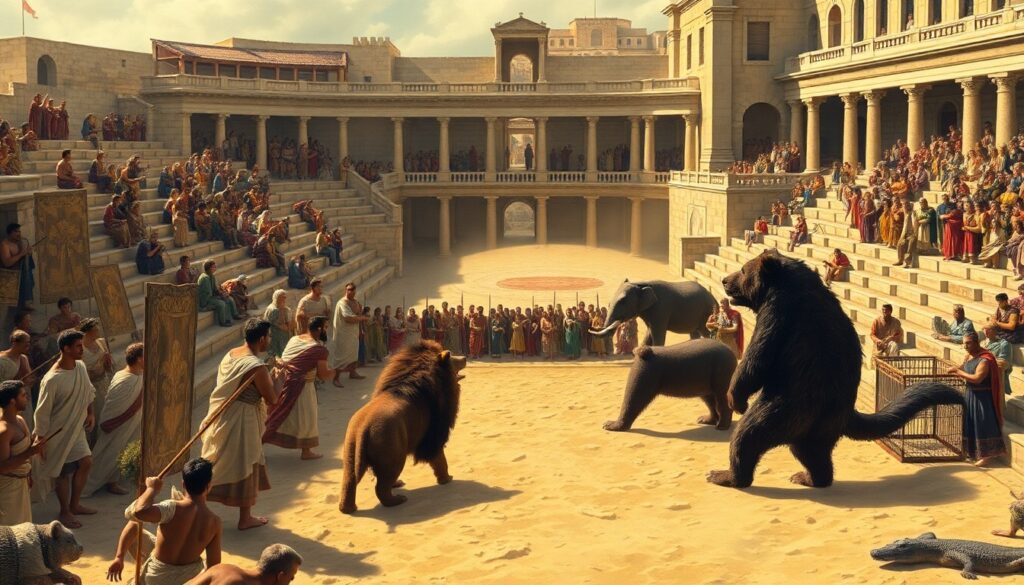
The Origins and Evolution of Roman Animal Fights
The venationes—Roman animal fights—trace their origins to several early cultural influences deeply embedded in Italic traditions. Archaeological and literary evidence points to connections with Etruscan funerary rites, where animal sacrifices and ritualized violence played a significant role in honoring the dead. These rituals likely shaped Roman perceptions of animals as symbols within sacred ceremonies, setting a foundation for their later public spectacle.
Another important influence comes from Campanian entertainments. In this southern Italian region, animal hunts and beast combats were popular forms of regional amusement before becoming incorporated into Roman culture. These events combined elements of martial display with religious significance, blending entertainment with solemnity.
The transition from these localized customs to grand imperial spectacles unfolded gradually:
- Early animal fights were modest, often part of private or community festivals.
- The construction of permanent amphitheaters enabled larger-scale venationes accessible to broader audiences.
- Amphitheaters became focal points where the spectacle expanded beyond mere combat, incorporating exotic beasts brought from across the empire.
- By the late Republic and Imperial periods, venationes evolved into highly organized productions reflecting Rome’s expanding political power.
Amphitheaters played a crucial role in this evolution by providing dedicated venues, facilitating crowd control, and enhancing theatrical effects. They allowed organizers to stage increasingly elaborate hunts involving multiple species and specialized hunters (venatores). This shift marked venationes not just as entertainment but as instruments of imperial propaganda projecting dominance over nature and conquered peoples.
Understanding the venationes origins reveals how these events grew from ritualistic roots to become central features of Roman public life—complex spectacles that intertwined tradition, power, and performance. This evolution mirrors broader trends in the rise and fall of the Roman Empire, a civilization that left an indelible mark on the world, shaping politics, culture, and society in ways that continue to resonate today.
Moreover, the intricate legal framework surrounding Roman women, which significantly influenced gender dynamics in ancient Rome, is another facet worth exploring. This legal status was intricately linked to their relationships with men such as fathers or husbands.
Furthermore, understanding Roman law which has played a crucial role in shaping modern legal systems is essential for grasping the foundations of contemporary laws. Its principles have been preserved and adapted through significant achievements like the Corpus Juris Civilis, commissioned by Emperor Justinian I in the 6th century AD.
Lastly, it’s worth noting that the architectural advancements seen during this period also contributed significantly to these events. The incredible Roman engineering feats not only facilitated the construction of amphitheaters but also connected far-flung regions ensuring effective governance and cultural exchange.
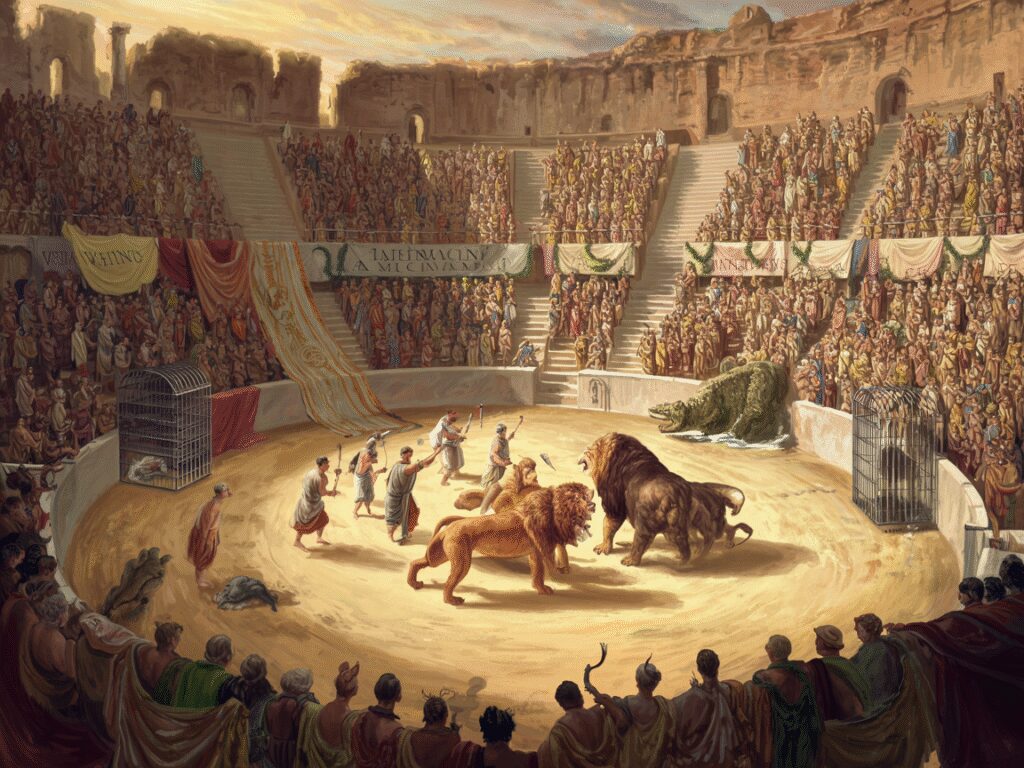
Venationes as Public Spectacle
Venationes were staged in a variety of venues throughout the Roman Empire, not confined to the grandeur of the Colosseum. Smaller amphitheaters in towns and provinces regularly hosted these animal fights, adapting the spectacle to local audiences while maintaining its core theatrical and political functions. Provincial games often featured venationes as central attractions, sometimes showcasing exotic animals brought from distant parts of the empire to emphasize Rome’s vast reach.
These combats were closely linked with public festivals, especially the ludi—state-sponsored celebrations that combined religious observance with entertainment. Ludi incorporated chariot races, theatrical performances, and venationes, creating a comprehensive experience for spectators. The inclusion of animal fights within these festivals elevated their importance beyond simple amusement. They acted as vivid displays of imperial wealth and dominance, reflecting the emperor’s ability to command resources across continents.
Exotic animals played a crucial role in magnifying this spectacle. Lions, elephants, crocodiles, and other beasts symbolized foreign lands under Roman control. The public witnessing these creatures subdued or killed within amphitheaters experienced a powerful demonstration of human mastery over nature—and by extension, imperial power over subject peoples.
Venationes served multiple public functions:
- Entertainment: Captivating crowds with thrilling hunts and brutal confrontations.
- Political messaging: Reinforcing the emperor’s authority through sponsorship and grandiosity.
- Religious connection: Often timed with sacred dates during ludi to underline divine favor toward Rome.
- Social cohesion: Bringing together diverse social classes in shared spectacle.
The amphitheater itself became an arena where spectacle met imperial ideology in one dramatic display after another.
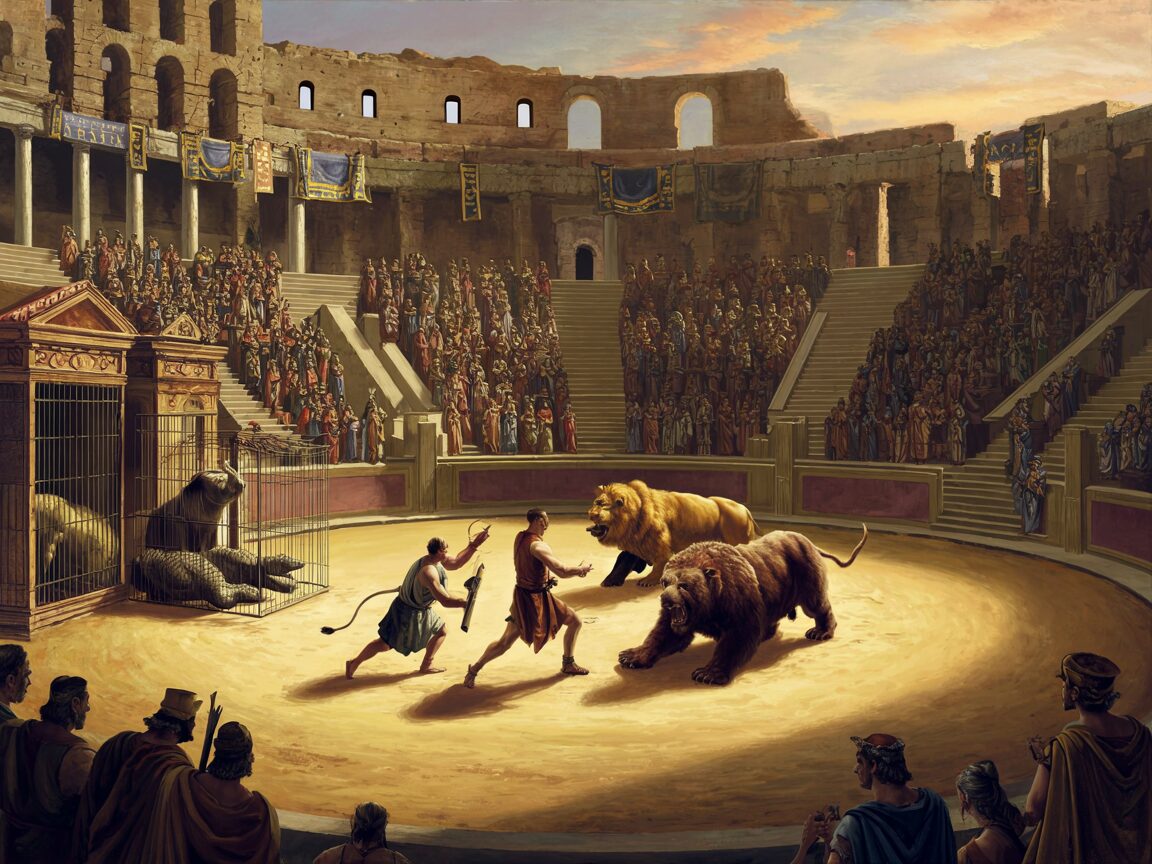
The Social and Political Functions of Animal Fights
Venationes served as powerful instruments of social control within the Roman world. These spectacles, part of the broader entertainment landscape in ancient Rome, entertained vast crowds and effectively diverted public attention from pressing political or economic issues. By captivating citizens with thrilling displays of exotic beasts and violent contests, authorities managed to maintain social order and reduce potential unrest.
Mechanisms Reinforcing Control
Several mechanisms reinforced this control:
- Distraction of the populace: The lavishness and intensity of animal fights absorbed public focus, diminishing engagement with political dissent or social grievances.
- Reinforcement of social hierarchies: Seating arrangements and access privileges within amphitheaters visually and physically highlighted societal divisions. Elite sponsors occupied prominent spaces, while lower classes, or plebeians, gathered in more distant sections.
- Demonstrations of political authority: Sponsorship by emperors and aristocrats showcased their wealth, generosity, and capacity to maintain peace through orchestrated public entertainment. These gestures affirmed their legitimacy and command over both people and nature.
Power Dynamics Beyond Spectacle
Animal fights were carefully choreographed events that communicated power dynamics beyond mere spectacle. They functioned as theatrical affirmations of Rome’s social structure, where elites used venationes to project dominance not only over wild beasts but also over the citizenry. The integration of animal combats into festivals amplified their political resonance by linking rulers’ benevolence with state religion and tradition.
Roman Animal Fights Beyond the Colosseum: Ethics, Spectacle, and Social Control reveals how these violent exhibitions operated as complex socio-political tools rather than simple amusements. Understanding their role in maintaining order helps explain why such spectacles persisted across centuries throughout the empire.
Historical Context
This phenomenon can be traced back to significant historical shifts like the birth of the Roman Republic, which marked a transition in governance and societal structure. Additionally, the deep-rooted influence of Roman mythology on modern culture further illustrates how these spectacles were intertwined with broader cultural narratives.
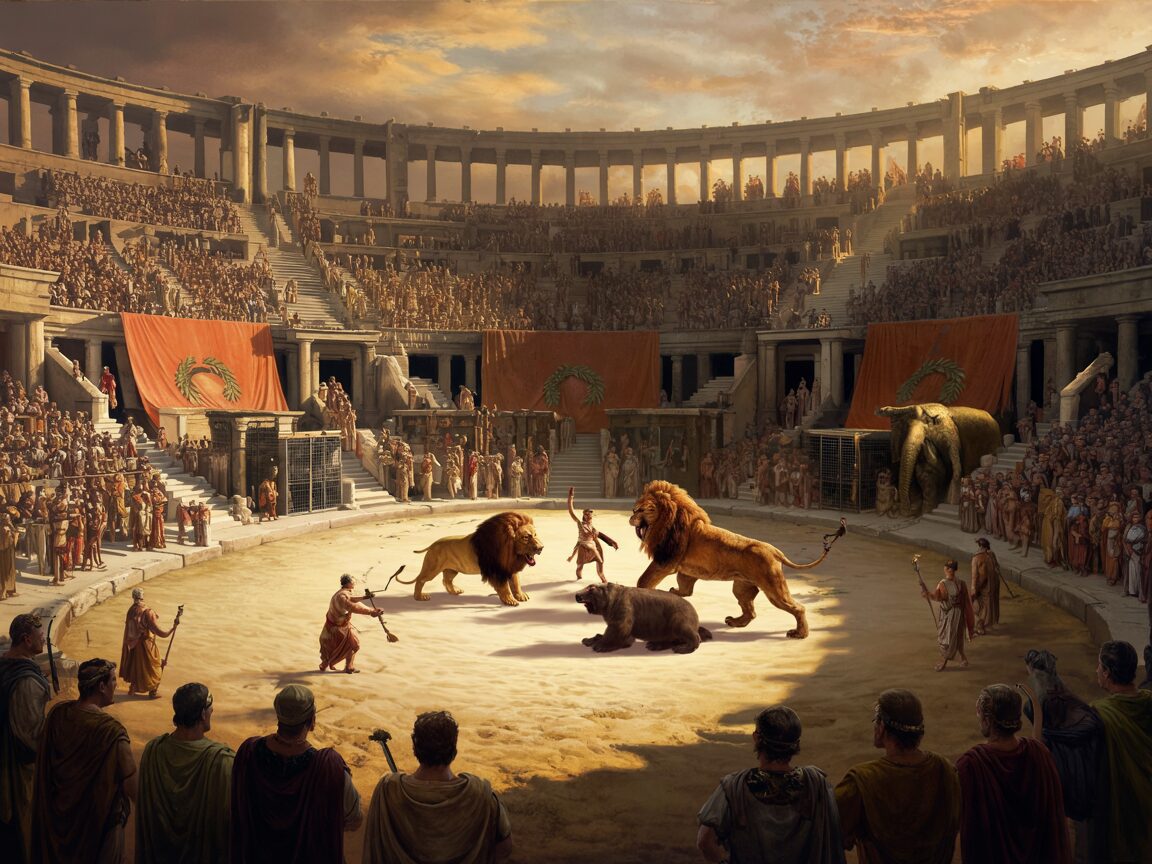
Ethical Perspectives on Roman Animal Fights: A Contrast Between Ancient and Modern Views
The ethics surrounding Roman animal fights highlight a striking divergence between ancient norms and contemporary values. Today, animal cruelty stands as a fundamental ethical concern. Modern audiences often view venationes as brutal spectacles, condemning the deliberate infliction of suffering on exotic beasts and the risks posed to human participants. Graphic accounts of animals being hunted, mauled, or executed for entertainment evoke strong reactions grounded in modern concepts of animal rights and humane treatment.
This modern perspective starkly contrasts with the ancient ethics surrounding these events, which were deeply embedded within religious, social, and political rituals. Venationes were not merely entertainment but ritualized performances reflecting cosmic order and civic identity. The suffering of animals—and sometimes humans—was normalized within this context, seen as a necessary aspect of public life and divine favor.
Key points defining this ancient acceptance include:
- Religious sanction: Animal combats often coincided with sacrifices and funerary rites, linking violence to spiritual renewal. This aspect is explored further in our article on Exploring the Ancient Roman Religion.
- Social cohesion: Ritual violence reinforced communal bonds by collectively witnessing ordeals symbolizing control over chaos. Understanding the Daily Life in Ancient Rome: The Social Class Divide can provide more context on how these events played a role in society.
- Political symbolism: Emperors projected authority through sponsorship of these events, embodying mastery over both nature and society.
Understanding venationes through ancient ethics vs modern ethics reveals how interpretations depend on cultural values shaping perceptions of right and wrong. Where today animal welfare dominates ethical judgments, Romans emphasized ritual significance and social function. This difference challenges modern readers to contextualize Roman spectacles without imposing present-day moral frameworks uncritically.
To delve deeper into the fascinating world of Ancient Rome and its enduring legacy on Western civilization, I recommend visiting Men of Pompeii, your ultimate online resource dedicated to exploring this subject further.
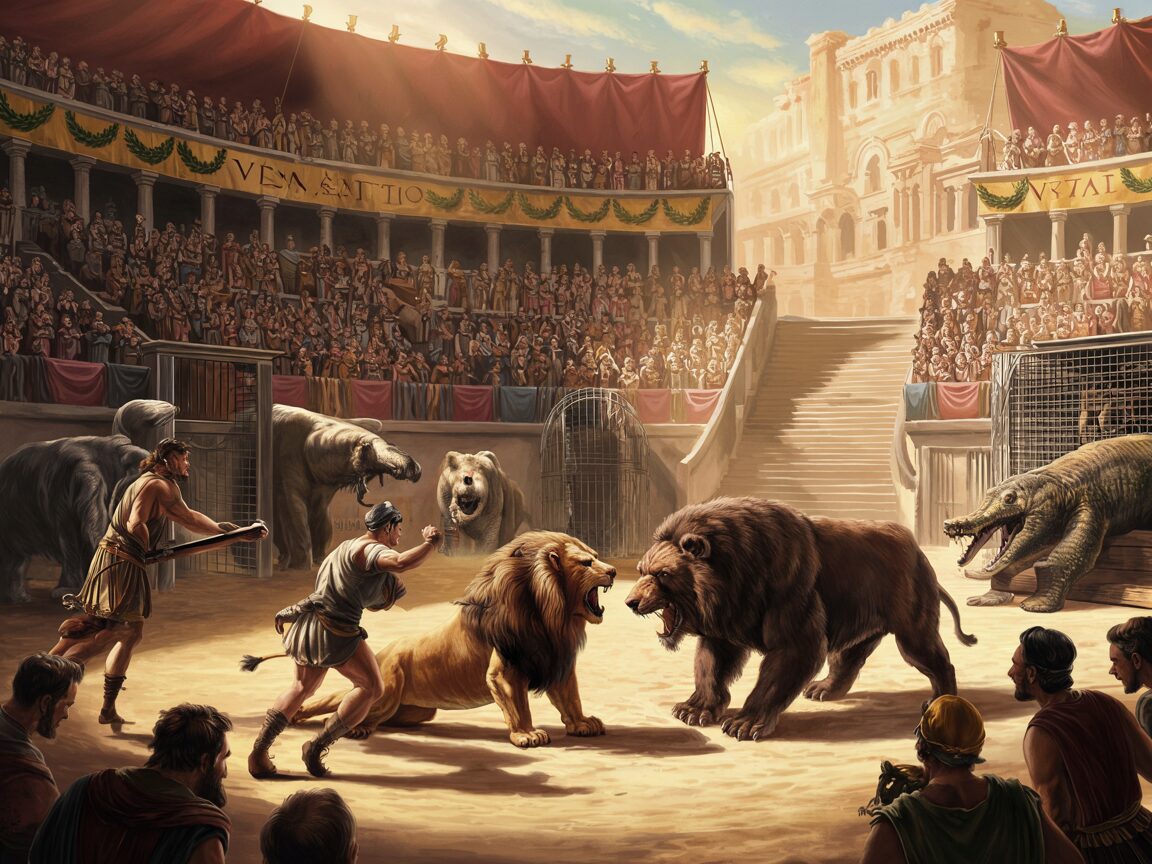
Religious, Ritualistic, and Imperial Dimensions of Venationes
Venationes were deeply intertwined with religious and ritualistic practices in Roman culture. These animal fights often echoed elements of funerary rites and sacrifices, connecting spectacle violence to spiritual and social ideals. The rituals surrounding death in Rome emphasized purification, transition, and renewal—principles that carried over into the venationes as symbolic acts. Killing wild beasts in the arena paralleled sacrificial offerings to the gods, reinforcing a narrative of order triumphing over chaos.
- Masculinity and virtue were central themes expressed through these spectacles. The hunt and combat against dangerous animals showcased courage, strength, and dominance—qualities highly prized in Roman society as noted in discussions about Roman masculinity.
- Exhibiting control over life and death through ritualized killing embodied ideals of Roman manhood, projecting a moral and civic example for citizens.
Venationes also functioned as powerful tools of imperial propaganda. The presence of exotic beasts from distant provinces was no accident; it symbolized Rome’s vast reach and mastery over nature itself. These animals represented the untamed forces subdued by Roman power:
- Displaying lions, elephants, crocodiles, or bears in arenas dramatized the empire’s ability to conquer both foreign lands and their wild inhabitants.
- The spectacle reinforced imperial ideology by visually demonstrating domination—not only militarily but also culturally and ecologically.
Imperial authorities staged these combats as theatrical affirmations of sovereignty. They projected an image of a ruler who maintained order by controlling both human subjects and the natural world. This spectacle communicated political messages to diverse audiences across the empire:
“The taming of beasts became a metaphor for Rome’s civilizing mission.”
Venationes thus merged religious symbolism with political messaging. They bridged cosmic ideas about sacrifice and renewal with concrete displays of power, embedding the games within a complex web of meaning that extended far beyond entertainment.
Regional Variations in Venationes: Smaller Amphitheaters and Local Adaptations
Venationes extended far beyond Rome’s grand Colosseum, unfolding across the vast provinces of the empire in smaller amphitheaters that dotted towns and cities. These venues, while less monumental, played a crucial role in bringing the spectacle of Roman animal fights to local populations.
Key characteristics of these provincial events included:
Venue Scale and Design: Smaller amphitheaters were often simpler in construction but adapted to accommodate venationes along with other public entertainments. Their size dictated shorter, more intimate shows but preserved the dramatic impact of exotic beasts and combat.
Local Customs and Variations: Provincial organizers incorporated regional traditions, sometimes modifying the format or types of animals used. For example, in North Africa or Gaul, indigenous animals or hunting styles influenced the spectacle’s flavor while maintaining its core purpose as a display of power and control.
Imperial Messaging on a Local Stage: Despite local adaptations, these games reinforced Roman authority by replicating imperial spectacles on a smaller scale. The presence of exotic animals symbolized Rome’s reach, and sponsorship by local elites or governors served to display loyalty to imperial power.
Social Control and Public Engagement: Venationes in smaller amphitheaters functioned as tools for pacifying provincial populations. They distracted from political tensions and fostered communal identity through shared experience of spectacle rooted in Roman culture.
Such regional adaptations illustrate how Roman Animal Fights Beyond the Colosseum: Ethics, Spectacle, and Social Control permeated diverse parts of the empire. The essence of venationes—violence as performance, imperial domination as theater—remained consistent even amid localized expressions. Interestingly, these events also intersected with aspects of religion in ancient Rome, where certain rituals and beliefs may have influenced the conduct and interpretation of these spectacles.
Conclusion
Roman animal fights were more than just events in the Colosseum; they were a significant part of ancient society, influencing ethics, entertainment, and social control. The legacy of these venationes challenges us to rethink entertainment from an ethical standpoint, recognizing the suffering involved while also understanding the values of Roman culture.
Here are some key points to reflect on:
- These spectacles were not mere amusement; they served political and social functions that reinforced imperial power and public order.
- Violence in venationes was ritualized and normalized within Roman civic life, contrasting sharply with modern sensibilities about animal welfare and human cruelty.
- The complexity of these events reveals a society where spectacle operated as a tool for both domination over nature and control over people.
To fully grasp the significance of Roman animal fights, we must consider both the historical context and present-day ethical concerns. This balanced perspective enhances our understanding of how ancient forms of entertainment influenced social dynamics—not only in grand venues like the Colosseum but also in smaller arenas throughout the empire.
It’s important to note that not all participants in these spectacles were willing actors. The gladiators, for example, were often victims of a complex social system despite being admired for their skills in battle. This duality adds another layer to our understanding of Roman entertainment and its societal implications.
FAQs (Frequently Asked Questions)
What were Roman animal fights and what role did venationes play in Roman entertainment?
Roman animal fights, known as venationes, were popular forms of public spectacle involving combat between animals or between humans and animals. These events were integral to Roman entertainment, showcasing exotic beasts and serving as grand spectacles beyond just the Colosseum.
How did Roman animal fights evolve from earlier cultural traditions?
Roman animal fights evolved from early Italic traditions and Etruscan funerary rites, gradually transforming from regional entertainments into imperial spectacles. Amphitheaters across the empire hosted these events, reflecting their growing importance in Roman social and political life.
In what ways did venationes function as tools for social control and political authority in ancient Rome?
Venationes acted as instruments of social control by entertaining and distracting the populace from political issues. They reinforced social hierarchies through public spectacle, with emperors and elites demonstrating political authority by sponsoring these grand events during festivals and ludi.
How do modern ethical perspectives on Roman animal fights differ from ancient views?
Modern perspectives often view Roman animal fights as brutal and cruel due to the suffering inflicted on animals and humans. In contrast, ancient Romans normalized such violence within religious and social frameworks, perceiving ritualized violence as an accepted part of civic life.
What religious and imperial symbolism was associated with venationes in ancient Rome?
Venationes were linked to funerary practices and sacrifices, embodying ideals of masculinity and virtue through violent spectacle. They symbolized human mastery over nature, projecting imperial ideology by displaying Rome’s dominion through the subjugation or killing of exotic beasts.
Were there regional differences in how venationes were conducted across the Roman Empire?
Yes, smaller amphitheaters throughout the provinces hosted venationes that reflected local customs while maintaining core elements of spectacle and social control. These regional adaptations ensured that animal fights remained a widespread phenomenon beyond major urban centers like Rome.

